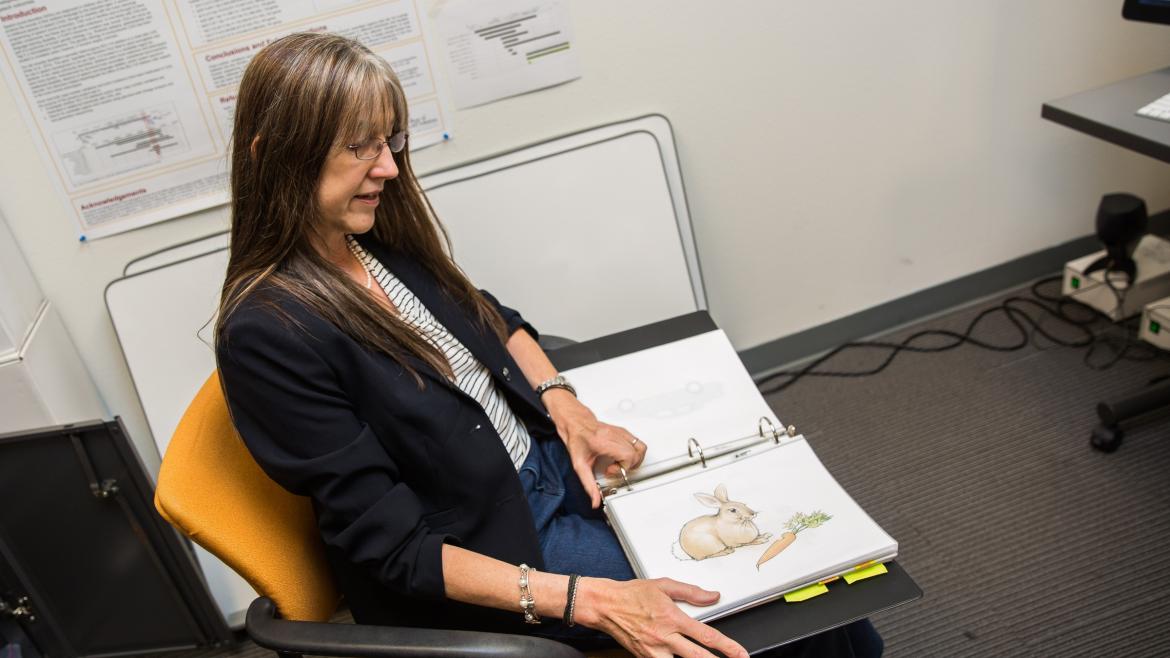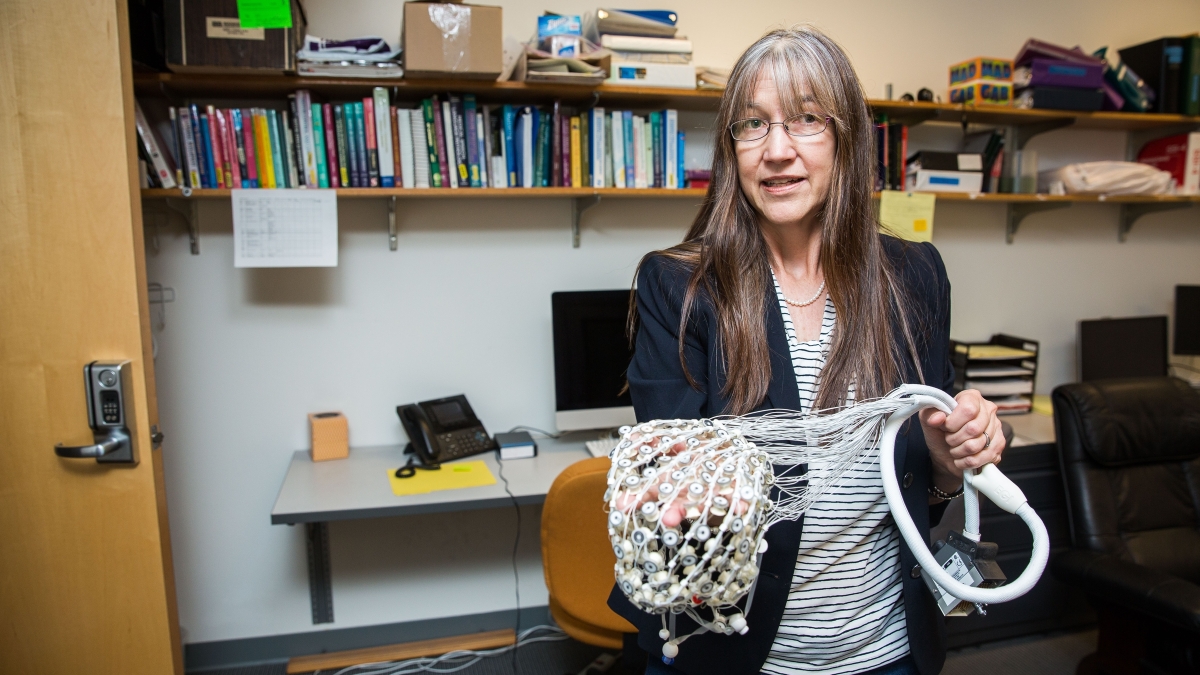People take preventative measures every day. We use seat belts to prevent injury, wear sunscreen to prevent skin damage and lock our doors to prevent burglaries. Any way you look at it, preventing a disaster is preferable to dealing with its aftermath.
The same holds true for medical disorders; prevention is always better than attempting to treat after diagnosis. For a great number of disorders, that’s not always possible. But thanks to the research of ASU assistant professor Beate PeterBeate Peter is an assistant professor of speech and hearing in Arizona State University’s College of Health Solutions., we are one step closer to being able to do this for childhood apraxia of speech, or CAS.
In a study published today in the leading scientific journal PLOS ONE, Peter (pictured above) details how she was able to identify mutations in mainly two genes that may cause the disorder. Knowing more about the genetics of speech problems will allow parents with children at risk for the disorder to take action earlier than was previously possible.
“One mother once told me, ‘He doesn’t have any friends — none of the kids at preschool want to play with him,’ ” Peter said. “So there is a huge area of need … to do more than just wait until they have a diagnosis and then treat.”
A former school-based speech-language pathologist, Peter thought that perhaps the answer to filling that need lay in our genes. And so in this, her latest study, Peter chose two separate families in which incidences of CAS were very high to delve into the genetics of speech disorders.
After running a battery of tests on the family members and asking them lots of questions to determine who among them did and did not have speech problems came the “most crucial” step: obtaining a DNA sample from each member of each family. For each of these DNA samples, Peter obtained computer files with more than half a million genetic markers spread across all chromosomes (imagine a huge text file with the markers for one entire family: dozens of columns and more than 9 million lines), and for a few samples, she also obtained computer files with readouts of the entire exome, which consists of all pieces of DNA that contain the recipes for making proteins.
Using a program developed by researchers at her alma mater the University of Washington, Peter fed each family’s genetic marker files into a computer to look for parts of chromosomes that likely were inherited along with the speech problem. Once she found these chromosomal regions, she checked them for harmful exome variants that were inherited only by family members with the speech problem.
What she found was that members of each family who were previously determined to have a speech problem also shared a specific gene marker. Members of each family who were previously determined not to have a speech problem did not have that specific gene marker; an indication that most likely, the gene marker shared by members of the family who have a speech problem is indicative of a shared genetic anomaly that likely caused the speech disorder.
For the first family, Peter found one specific gene variant on one chromosome and several others on another chromosome that were shared by members of the family with a speech problem. For the second family, she found only one specific gene variant shared by members of the family with a speech problem.
Hence, these candidate variants may cause the disorder.

ASU assistant professor Beate Peter flips through a binder of images she uses to determine the severity of speech disorders.
Photos by Deanna Dent/ASU Now
What is important to note is that each shared gene variant Peter found was located on a different chromosome — chromosomes 5 and 17 for the first family and chromosome 4 for the second family. Because of that, it cannot be definitively stated that one particular chromosome is responsible for CAS.
Rather, CAS can arise from a number of different genetic anomalies on a number of different chromosomes. This is not necessarily a new insight, as in the past, Peter and other researchers found a handful of candidate genes for CAS in different families. For example, a group in the United Kingdom discovered the first “speech” gene, called FOXP2, more than 15 years ago, and in the case of one boy Peter studied in 2014, a sporadic loss of a whole gene on chromosome 2 most likely caused him to have CAS. The discovery of the mutations found on chromosomes 4, 5 and 17, published today, adds new candidate genes to this short list. Peter’s project is the first since the discovery of the FOXP2 gene to study multigenerational families and land on mutations involving single DNA points.
“It’s like if you have a book with 6,000 pages and a crucial word is misspelled; the whole meaning of the book changes,” Peter said. “And so that’s what happened in these two families. This mutation affects the way that their speech motor system functions.”
Being able to identify the specific genetic variations that cause CAS and other severe speech disorders is a game-changer. In the very distant future it could allow for gene editing, wherein the genetic anomaly that causes the disorder is edited out of a person’s genomic makeup, thus eliminating the disorder. At present, it could mean much earlier diagnosis.
Right now, problems with speech development may be noticed around age 2, and an official CAS diagnosis can be made after age 3. Once the diagnosis is made, speech-language pathologists can set up a treatment plan. In families with prevalent CAS and a known genetic cause, parents can opt to have their new infants tested for the genetic change. Test results would tell parents whether to be extra vigilant and get professional help as early as possible, as opposed to waiting until the child is older and has already experienced detrimental delays in the development of their speech abilities.
One problem is that speech-language pathologists usually treat symptoms. What if they could provide approaches that prevent the speech problems from cropping up in the first place by working with tiny infants at genetic risk?
Peter hopes to begin clinical trials with just such infants as soon as 2017, collaborating with some of her colleagues who specialize in earliest phases of speech development. She is already in contact with local hospitals and clinics for patient referrals; the next step is to secure funding.
The kind of therapy Peter plans to employ in the trials would be a combination of reinforcement and operant conditioning, a learning principle in which environmental stimuli are controlled and manipulated to influence behavior.
Another “dream for the future,” as Peter describes it, is ultimately to incorporate brain imaging into the genetics research to be able “to study the pathway from the genetic variation, to the brain, to the observable speech output.”
She explains that the interdisciplinary nature of this type of work, even without the brain imaging, is extremely rare:
“There are very, very few people who study the genetics of speech disorders. There are more people who study the genetics of language disorders and the genetics of reading disorders (such as dyslexia). But speech sound disorders, there are few people who have the dual training for that. So ASU, with its focus on interdisciplinarity, is the perfect place [for this type of work].”
Top photo: Beate Peter holds an EEG net, a medical device used to produce images of brain activity. A device such as this may be used in further studies of hers looking at the pathway from genetic variations that cause speech disorders, to the brain, to the observable speech output.
More Health and medicine
ASU team part of nationwide study looking at Type 2 diabetes in youth
Near the end of an interview in which he talked about the work his team will be doing to tackle the rise in Type 2 diabetes among youth, Arizona State University Professor Gabe Shaibi answered why…
Leading the way in wellness: ASU highlighted in The Princeton Review's 2025 Mental Health Services Honor Roll
Being a college student isn’t easy — navigating new routines, people and places can be a challenge, especially if the right support system is not in place. That's why Arizona State University is a…
New Indigenous health dashboard offers robust database for scholars
By Nicole Greason and Kimberly Linn A team at Arizona State University’s College of Health Solutions and American Indian Studies program has created a new tool to aid researchers…
